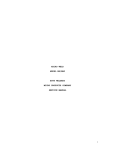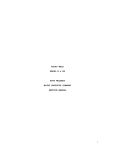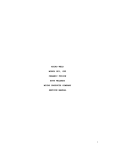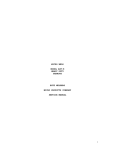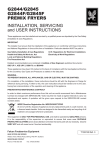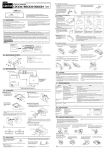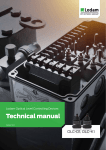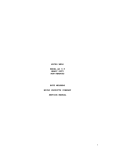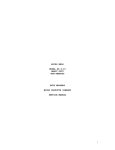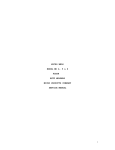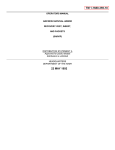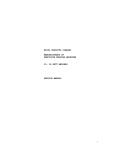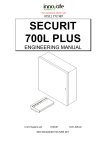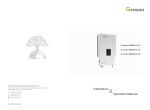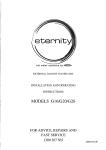Download HP-1 Manual - Micro Products Company
Transcript
MICRO WELD MODEL HP-1 CERAMIC FUSION BUTT WELDERS MICRO PRODUCTS COMPANY SERVICE MANUAL 1 TABLE OF CONTENTS 1.0 2.0 3.0 4.0 5.0 6.0 7.0 8.0 9.0 10.0 11.0 12.0 13.0 1.0 SPECIFICATIONS GENERAL OPERATING INSTRUCTIONS BASIC OPERATING PARTS BASIC OPERATING PARTS LOCATION TYPICAL OPERATING SEQUENCE SPECIAL ADJUSTMENTS PREVENTIVE MAINTENACE SUGGESTED SETTINGS DIAGNOISTIC CHART FOR TROULBE-SHOOTING ELECTRICAL SCHEMATIC SAFETY REMINDERS BUYERS GUIDE PARTS LIST SPECIFICATIONS MODEL HP1 Type of Welding Process Welding Range Material Suitability Standard Operating Voltages Maximum Line Demand 460 Volt Maximum Line Demand 230 Volt Single Phase AC Transformer Clamp Method Upset Method Mounting Ceramic Fusion 4/0 to 8ga AWG-Copper 250MCM to 8GA Aluminum Strand or Bunched Conductor 460/230 Volts 37amps@100% duty cycle 117amps@10% duty cycle 74amps@100% duty cycle 234amps@10% duty cycle 24 KVA @ 50% duty cycle Pneumatic, Foot Controlled Pneumatic, Adjustable 4-Caster Wheels Dimensions and Weights Height Overall Floor or Bench space Welding Die Height Weight 46”-Truck 39” x 29” Truck Type 41” – Truck Type 640 LBS – Truck Type FEATURES OF MICRO-WELD CERAMIC FUSION WELDING EQUIPMENT • • • • • • • • • Micro Weld quality and workmanship Heavy-duty construction & components East to operate controls Low maintenance costs Easy to set welding parameters Safety electrical switch circuits Heavy-duty weld heat selection switch No-upset burr formation during weld process, all strands locked into weld coalescence Sensitive straight slide movable headpiece assembly equipped with ball bearings 2 2.0 GENERAL OPERATING INSTRUCIONS 2.1 ELECTRICAL HOOK-UP INSTRUCTIONS First determine that available electrical service in your plant corresponds to the nameplate rating located on welder housing. Electrical wiring to welder must be of sufficient size to deliver full ampere load with no appreciable loss during weld cycle. The welder will not operate properly if there is more than a 10% variation in the line voltage. In general, the welder should be fused with a slow blow fuse of the 100% duty cycle rating. The minimum power cable size to the welder can be obtained by using this same current rating. Refer to National Electrical Code and local electrical regulations for adequate power sizes; disconnect methods and fusing guidelines. Remember line voltages to the welding machine are potentially dangerous should the power cords be damaged or severed. The welding voltages at the welding dies will not harm an operator since they do not exceed 10 volts. 2.2 SAFETY PRECAUTIONS (See section 11.0) 2.2.1 ELECTRICAL Maintain electrical cable to welder in good repair. Welder must be grounded and connections securely tightened. Heat Switch must not be changed to new position while a weld cycle is in process. Disconnect electrical service before serving welder – high voltages are located within the base of the welder. 2.2.2 MECHANICAL Operator while using welder must wear safety glasses. Keep all safety guards on welders and use properly. Operators must be instructed on basic operation of unit to prevent injury. Check nameplate rating and keep within material size range for each welder. 2.3 WATER HOOK-UP (If so equipped) It is important that if a welder is to be operated for an extended period of time and heats up, water lines must be connected to the welder. Connect hoses to inlet and outlet provided at the back of the welder. A Shut-off valve should 3 be installed in the inlet line and the hose from the outlet should run to an open sight drain. Water should be turned off when welder is not in use. 2.4 AIR HOOK-UP Set air regulators for from 20 to 80 lbs. A safety pop-off valve will be activated when air gauge is set for over 100 lbs. 2.5 WELDING DIES The dies and shoes supplied with the welder will handle most size and material types within the range of the welder. For new weld applications consult the factory for special die and shoe sets. 3.0 BASIC OPERATING PARTS 3.1 WELD HEAT SELECTION SWITCH Welding heat is selected by means of a heavy-duty tap switch, offering twelve (12) steps of voltage. The switch is located conveniently on the lower front of the welder. Number one (1) indicates high heat; twelve (12) indicates low welding heat. Other numbers are equally graduated from high to low to allow just the right amount of voltage for the weld operation. 3.2 LIMIT SWITCH The weld switch is located on the upset cylinder bracket behind the upset cylinder. Limit switch adjustment is made by moving the switch-initiating barrel along the threaded stud mounted in the movable headpiece. The weld limit switch controls the cut of current flow to the welding dies. 3.3 HEAD SPACING MECHANISM The open head space adjustment bolt and locking jam nut are located on the upset cylinder mounting plate to the immediate left front of the upset cylinder, The open space scale also located on the front of the upset cylinder mounting is a quick reference guide for determining the amount of open space by lining up the pointer on the movable head endplate with the graduations on the scale. When the pointer is in line with no. “0” on the scale, there is 3/8” between the inside of the welding dies. There 4 is an increase of ¼” spacing between the dies for each graduation on the scale. The headpiece closed stop is preset at the factory and should require no field attention. This setting will prevent the dies from touching each other if the upset is activated with no stock in the dies. To check this setting push movable headpiece to the full closed space then you should measure 3/8” between the welding dies. 3.4 CLAMP ARMS The clamp arms are air operated. The foot controlled air valves are used to initiate the air clamp cylinders. The foot valves are located at the bottom of the welder housing. The right foot pedal operates the right clamp arm, and the left pedal operates the left clamp arm. To clamp stock place it in the proper welding die grooves and press the top edges of the tilt pedal on the foot valve. To release stock, press on bottom edge of foot valve tilt pedal. Air flowing into each clamp cylinder is slowed by a flow valve that is preset at the factory. CAUTIOM: Care must be used when clamping stock, be sure hands are clear of clamp arms. 3.5 WELDING DIES The welding dies (lower) and shoes (upper), serve two purposes: 1. To carry current for welding. 2. To prevent slippage during weld cycle. 3.6 WELD SPLIT SLEEVE The split sleeve serves two purposes: 1. To provide proper alignment. 2. To form weld zone keeping all strands together. With the unique design each sleeve can be used many times. 5 4.0 BASIC OPERATING PARTS LOCATION 6 5.0 TYPICAL OPERATING SEQUENCE 5.1 All insulating materials must be removed from conductors where they contact lower welding dies. Set weld heat selection switch to recommended chart setting. Set upset pressure to recommended chart setting (PSI). Adjust the head open space to proper chart setting. Twist end of conductor in direction of natural lay, pulling outward. Carefully square cut conductor end so no individual wires extend beyond cut. Note: Use a sharp sheer, because end preparations are important. Select correct ceramic sleeve or split sleeve set for wire to be welded. Thread conductor into sleeve so that the wire ends are midway through sleeve. Rotating sleeve in direction of lay will assist threading procedures. Clamp preset conductor and sleeve into welding die set, so that the sleeve is centered between open welding dies. Thread other prepared conductor into sleeve and allow the conductor to gently but firmly contact first conductor. Positive contact to wire ends is important for a good weld. Clamp that conductor into welding die. Rotate and center ceramic (or split) sleeve to assure free movement of conductors during the weld process. Lower the flash guard and raise up on the operating lever until it initiates the operation switch, hold for 1 to 3 seconds to assure a complete weld cycle. Unclamp welded conductors and remove sleeve. Fracture expendable type or disassemble reusable type. The inside diameter of the sleeve slightly exceeds the nominal conductor size; therefore the weld zone is slightly larger than conductor diameter. 5.2 5.3 5.4 5.5 5.6 5.7 5.8 5.9 5.10 5.11 5.12 5.13 5.14 7 6.0 SPECIAL ADJUSTMENTS 6.1 HEADPICE OPEN SPACE ADJUSTMENTS The typical open space for the HP Welder should be set at 4-1/2 on the open space scale. If the open space need adjusting, loosen the locknut on the open space bolt to increase the open space turn clockwise, to decrease the open space turn the bolt counterclockwise after adjusting retighten locknut. (See suggested settings). 6.2 LIMIT SWITCH The weld limit switch adjustment is typically set at 4-1/2 on the threaded rod scale. If the weld limit needs adjusting loosen the locknut on the threaded rod, turn activating nut clockwise to cut off sooner or turn the nut counterclockwise to cut off later. (See suggested settings). 6.3 UPSET PRESSURE A pressure regulator with gauge controls the upset pressure. To change the upset pressure loosen the locknut on the adjusting knob screw, to increase pressure turn knob clockwise, to decrease pressure turn knob counterclockwise, retighten locknut after adjustment has been made. 6.4 CLAMP PRESSURE A pressure regulator with gauge controls the clamp pressure. To change the clamp pressure, loosen the locknut on the adjusting knob screw, to increase pressure turn knob clockwise to decrease pressure turn knob counterclockwise, retighten locknut after adjustment has been made. 8 7.0 PREVENTIVE MAINTENANCE TECHNIQUE Keep in Mind that these welders are precision built to last many years, but will require good maintenance procedures. They are designed to be as automatic as possible with a minimum dependence on the ability of the operator. Adjustments must be made by those thoroughly familiar with the operating principles of the welders. 7.1 WELDING DIE NOTES 7.1.1 Welding dies and die shoes in poor condition are the primary caused of bad welds. 7.1.2 Check die sets for excessive wear and replace if necessary. 7.1.3 Clean weld die bottoms to remove oxides with emery cloth placed on a flat surface. 7.1.4 Clean die seats with emery cloth to brighten contact areas. 7.1.5 After cleaning of dies be sure to wipe off with soft clean cloth. 7.1.6 Completely tighten dies into seats to assure a good contact. 7.1.7 Worn die shoes will not hold stock during a weld cycle, change steel faces or replace complete shoes. 7.2 WEEKLY 7.2.1 Tighten all loose parts. 7.3 QUARTERLY 7.3.1 Repeat above service items. 7.3.2 Check grease requirements on clamp arms pivot shafts and lubrication points. 7.3.3 Check anneal parts and replace all worn or broken assemblies 7.3.4 Check contacts on magnetic contactor for worn contacts. 7.3.5 Clean heat switch contacts with low residue cleaner and recoat with petroleum jelly. 7.4 ANNUALLY 7.4.1 Repeat previously noted items. 7.4.2 Check for wear in clap arm pivots. 7.4.3 Clean inside and outside of welder. 7.4.4 Check grease requirements on headpiece slide shafts, grease lightly. 7.4.5 Caution: make sure that power supply is disconnected before servicing welder in anyway! 9 7.5 WELDING DIES AND DIE SHOES INFORMATION Description: Welding dies – Lower conducting electrode and clamp jaw. Welding die shoes – Upper clamping member. Welding dies and die shoes in poor condition are the main causes of bad welds. Care of die sets: 7.5.1 Use a brass or fiber blade to remove particles of flashings that build-up on die sets. Excessive flash build-up causes die burns on material and shorting of die sets. 7.5.2 Do no attempt to clamp material that is not suited for welder into die sets. Undersize materials will slip and burn die grooves, oversize materials will overstress clamping parts. 7.5.3 Do not use welding die sets for a vise. not withstand the mechanical abuse. These parts will 7.5.4 Whenever welding dies are replaced, clean bottoms of dies and corresponding die seats to a bright and clean condition before bolting them tightly into place. An oxidized surface will insulate the welding dies and reduce effective welding voltage. 7.5.5 Welding die shoes must swivel freely within the clamp arm pivots to prevent cracking of die shoes. File down die shoe boss if necessary. 7.5.6 Welding die set will ear with use and must be changed occasionally for good welding results. Keep and adequate supply of replacement parts available. Wire and rod slippage is a problem caused by poor die sets and a major cause of wire breaks. 10 8.0 SIZE 8 GA 6 GA 4 GA 3 GA 2 GA 1 GA 1/0 2/0 3/0 4/0 8 GA 6 GA 4 GA 3 GA 2 GA 1 GA 1/0 2/0 3/0 4/0 SUGGESTED SETTINGS MATERIAL Copper Copper Copper Copper Copper Copper Copper Copper Copper Copper Aluminum Aluminum Aluminum Aluminum Aluminum Aluminum Aluminum Aluminum Aluminum Aluminum WELD HEAT SETTING 10 9 8 8 8 7 7 7 6 6 12 11 10 10 10 or 9 9 9 9 8 8 or 7 HEAD OPEN SPACE 4 ½ 4 ½ 4 ½ 4 ½ 4 ½ 4 ½ 4 ½ 4 ½ 4 ½ 4 ½ 4 ½ 4 ½ 4 ½ 4 ½ 4 ½ 4 ½ 4 ½ 4 ½ 4 ½ 4 ½ LIMIT SWITCH SETTING 4 ½ 4 ½ 4 ½ 4 ½ 4 ½ 4 ½ 4 ½ 4 ½ 4 ½ 4 ½ 4 ½ 4 ½ 4 ½ 4 ½ 4 ½ 4 ½ 4 ½ 4 ½ 4 ½ 4 ½ AIR UPSET 20 PSI 20 PSI 20 PSI 25 PSI 25 PSI 25 PSI 30 PSI 40 PSI 45 PSI 50 PSI 15 PSI 15 PSI 15 PSI 20 PSI 20 PSI 25 PSI 25 PSI 30 PSI 35 PSI 40 PSI AIR CLAMP 60 PSI 60 PSI 60 PSI 60 PSI 60 PSI 60 PSI 60 PSI 60 PSI 60 PSI 60 PSI 60 PSI 60 PSI 60 PSI 60 PSI 60 PSI 60 PSI 60 PSI 60 PSI 60 PSI 60 PSI NOTE: These settings are approximate and may be varied to obtain the best weld. 8.1 WELDED STRAND OR BUNCHED COPPER AND ALUMINUM WIRE CONDUCTORS Theory: Welds are formed within a ceramic tube or block and no filler materials are needed. Wire ends are resistance heated to a plastic condition and hot forged together within a ceramic tool, which acts as a crucible. The resultant coalescence (weld) locks all single filaments into a solid weld zone…Since strand conductors have configuration voids on the faying surfaces, the plastic material normally forced to the outside on a normal weld, is forced into the voids eliminating the upset burr common with standard upset weld. (This type of weld is not suitable for solid wire.) 11 8.2 CERAMIC FUSION TECHNIQUE 9.0 DIAGNOSTIC CHART FOR TROUBLE-SHOOTING 9.0.1 SERVICE HINTS FOR STRAND CONDUCTOR WELDERS Conductors must be able to slide freely within ceramic tools during weld cycle, therefore rotate and move ceramic tool side to side prior to welding. Be sure to center ceramic tool between die sets. 12 Porosity and voids in weld zone may be corrected by using one or more of the following suggestions. 1. Increase upset pressure. 2. Decrease weld heat 3. Readjust timing point of weld heat cut-off, limit switch adjustment, to allow heat to cut-off slightly sooner. 4. Check to make sure conductor is not binding in ceramic tool. Amount and length of weld nugget (solid portion of weld) can be varied by one or more of the following suggestions. 1. Increase starting space between die sets when weld nugget is small. 2. Decrease space between die sets when weld nugget is too large. 3. Adjusting limit switch to hold on or cut-off current at a different position. 13 Fracturing of ceramic tools and bent conductors can be corrected by one or more of the following methods. 1. Decrease weld heat to prevent excessive softening of conductors on either side of sleeve. 2. Decrease starting space so as to decrease length of upset and amount of conductor exposed to heat. 3. Decrease upset pressure and still maintain a fused area. 4. A few of the very small stranded and bunched conductors just do not have enough mechanical strength to be processed by this process. 9.1 ELECTRICAL TROUBLE-SHOOTING OF WELDER (Caution!! Extreme care should be exercised when making these tests. Dangerous voltages are present in the welder. Only persons familiar with electrical safety precautions should perform these tests.) 9.1.1 TROUBLE-SHOOTING TABLE (See section 9.1.3) This electrical trouble-shooting table is furnished as a suggested method of trouble-shooting the welder. The individual steps of the table should be performed in the order given, to make the tests valid. The electrical schematic (section 10) furnished for these tests show the table test points. The table may be used for welders with a different but closely related wiring by using corresponding test points. During all tests, line voltage should be connected to L1 & L2 of the welder. The heat switch should be set to the #1 position. 9.1.2 FINAL ELECTRICAL CHECKS Set the heat switch to the number 1 position, connect the voltmeter across the welding dies. Press the operating switch. The meter reading will typically be less than 10 VAC. Consult the weld specification sheet for this value. Rotate the heat switch through all settings. If the voltage is not read at any setting, the heat switch may be defective. Actuate the weld limit switch; observe the reading goes to zero. Release the weld limit and operating switches, the reading should remain at zero. 14 9.1.3 TEST LEAD CONNECTION X1 X2 X2 FU1-1 X2 FU1-2 X2 LS1-1 X2 LS1-2 X2 LS2-1 X2 LS2-2 X2 LS3-1 X2 LS3-2 L2 CR1-1 L2 CR1-2 L1 S1-1 METER READING 115 VAC 115 VAC 115 VAC 115 VAC 115 VAC 115 VAC 115 VAC 115 VAC 115 VAC Line voltage Line voltage Line voltage PROBLEM IF NO READING Bad control transformer (T1) Bad fuse connection Open fuse Open wire to operating switch Bad operating switch Open wire to flashguard switch Open flashguard switch Open wire to weld limit switch Bad weld limit switch Open wiring to contactor Bad contactor Open wire to heat switch PRESS OPERATING SWITCH WELD LIMIT SWITCH ACTUATED PRESS ANNEAL SWITCH X X X X X X X NOTE: To perform repair consult section 13 for parts identification. 15 10.0 ELECTRICAL SCHEMATIC 16 11.0 SAFETY REMINDERS The following accident prevention information is presented to eliminate potential hazards while operating, inspecting or repairing Micro-Weld electric resistance welding equipment. Important safety compliance information for Micro-Weld Welders. GENERAL 1. Qualified personnel, prior to using equipment, must instruct an operator on basic operation and malfunction methods. 2. Safety eyeglasses must be worn by all personnel operating or servicing welders. 3. Use safety equipment properly and keep safety equipment on welders. 4. Determine that both operating voltages and hertz (cycles) of power supply correspond to ratings listed on welder nameplate located on welder housing. 5. Check nameplate ratings and keep within capacities and material categories stated therein. 6. Adjustments or repairs must be made by persons thoroughly familiar with operating principles of welder. 7. Welder must be disconnected from power supply prior to maintenance or repair procedures. ELECTRICAL 1. Refer to National Electrical Code and local regulations for adequate electrical wiring to power welder. Do not operate welder with inadequate electrical power supply cords or cable. 2. All welders must be grounded through power supply and welder ground connection terminal securely tightened. 3. All welders must be able to be disconnected from power source either by a double breaking disconnect switch or unplugged by standard rated plugs. 4. All welders must be fused to prevent injury should an electrical malfunction occur. Welders must never be fused for an ampere load that exceeds the ratings stated on welder nameplate. Normally welders are fused using the nameplate rated load; time lag parameters functional to standard fuses allow this specification. 5. Electric power cords to welder must be kept in good condition. Report any damage or potential hazards to maintenance personnel. 6. The weld heat selection switch, potentiometer or range selection devices must not be changed to a new position while a weld operation is in process. 17 12.0 BUYERS GUIDE HOW TO ORDER PARTS: You must provide 1. Machine Model 2. Machine Serial Number 3. Voltage Then identify part(s) on part list (last page in book) and provide MICRO with the circled number. CALL MICRO at 800-872-1068 OR FAX MICRO at 630-787-9360 Provide MICRO with your company name and purchase order number. 18 13.0 PARTS LIST 19 20 PARTS LIST HP WELDER MODEL/ PART NO DESCRIPTION HP-01A Head assembly, stationary & movable casting w/shafts, match machined, state serial number HP-01B Complete headpiece w/all parts HP-02A Bearing, headpiece replacement HP-04 Protection sleeve, slide shafts HP-05 Screw, sleeve mounting HP-06 Washer, clamp arm pin, outer HP-07 Washer, clamp arm pin, inner HP-08L Clamp arm, left HP-08R Clamp arm, right HP-09 Clamp arm pivot pins HP-10 Bolt, clamp arm pin, outer HP-11 Bolt, clamp arm pin, inner HP-15 Bolt, transformer secondary strap, movable head HP-16 Bolt, transformer secondary strap, stationary head HP-17 End plate, transformer secondary strap, stationary head HP-18 Return spring, headpiece HP-19 End plate assembly, movable HP-19A Limit switch scale screw HP-20 End plate mounting screw HP-21 Grease fitting, stationary head, bent HP-23 Closed head stop button HP-24 Clamp cylinder, type #20, complete HP-25 Boot, shaft protecting type #20 HP-26 Diaphragm, type #20 HP-30 Insulation, upset frame HP-31 Insulating washers & tube set HP-32 Steel washers HP-33 Upset frame mounting screw HP-34 Bolt & nut, head adjusting, open HP-35 Scale, open head positioning HP-36 Scale mounting screw HP-37A Limit switch, roller activated HP-37B Limit switch, magnetic proximity HP-37C Cover, limit switch, roller type HP-41 Actuator, limit switch, cut-off HP-41A Limit switch actuator locknut HP-43A Clevis, upset cylinder HP-45 Upset cylinder HP-45A Clevis HP-53A Protection plate, transformer HP-53B Protection plate riser HP-55 Upset cylinder mounting plate HP-57 Welding die attaching screw, lower ITEM # 31051 31059 48402 31014 90821 31546 31006 31017 31030 31000 90632 90835 90509 90659 51000 80014 41068 31009 90260 48422 31012 77703 77715 77710 41011 31069 92751 90260 90302 41005 91048 57811 77819 51001 31008 31007 77812 77812 Application 41012 41009 41010 90660 21 PARTS LIST HP WELDER MODEL/ PART NO DESCRIPTION HP-58R Welding die set, 4 pieces, radius groove, state size HP-58AR Welding dies, radius groove, lower blocks only, state size HP-59 Steel washers, die shoe mounting HP-60 Die shoes, pair w/inserts HP-60F Die shoes, flat copper type no grooves HP-60L Steel die shoe, left HP-60R Steel die shoe, right HP-61 Complete set of inserts HP-61L Steel insert, left HP-61R Steel insert, right HP-61S Straight steel insert HP-62 Insert mount screw HP-68 Auto transformer used w/12 point tap switch HP-68P Auto transformer primary HP-72 Weld contactor, 460 volt HP-72 Weld contactor, 230 volt HP-72A Repair kit, contactor HP-74 Terminal block, power input HP-75 Terminal block mounting screw HP-76 Weld heat selection switch, 12 point HP-77 Weld transformer, 2 tap primary, state voltage and serial number HP-78P Replacement primary coil, 2 tap HP-78S Weld transformer, secondary HP-79 Shunt support bracket HP-80 Shunt support bracket HP-81 Swivel caster HP-82 Stationary caster HP-82W Replacement wheel only HP-85 Door HP-97 Foot pedal muffler HP-98 Foot valve complete HP-99 Foot valve mounting screw HP-109 Vise, standard HP-110 Mounting bracket, standard vise HP-111 Bolt & nut, vise mounting HP-123 Flow control valve, clamp arm HP-124 Safety flashguard HP-124A Bolts, flashguard attaching HP-124B Flashguard switch HP-125 Control transformer, switch circuits HP-125A Fuse, control transformer ITEM # 31046 31037 92753 31053 31036 31001 31002 31052 31004 31005 31003 90704 51019 51018 57610 57611 57631 53000 90205 56547 51027 53047 51026 51004 51004 48108 48117 Special 41014 77892 90611 90611 78112 60022 90261 77862 31056 90232 57813 57601 58100 22 PARTS LIST HP WELDER MODEL/ PART NO DESCRIPTION SS-900 Complete weld tool w/holder, 2, 3 or 4 match, state size SS-901 Insert only weld tool, 2,3 or 4 grooves, state size SS-902 Insert only weld tool, blank SS-903 Holder only, welding tool ITEM # 31064 31035 31034 31045 23























